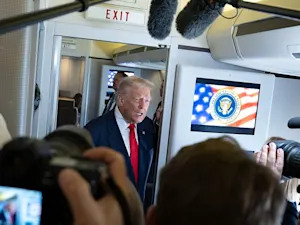
Mexico Fires Back After Google® Bows to Trump
President Claudia Sheinbaum, 2024. Photo courtesy of EneasMX under CC BY 4.0.
In her first high-drama move on the global stage, Mexico's new president Claudia Sheinbaum is suing Google® for labeling Mexican waters with a Trump-era rebrand — and it's already stirring up geopolitical chaos.
What started as a map edit on Google is now a diplomatic brawl between Mexico, the United States, Big Tech, and Donald Trump. At the heart of the lawsuit? A change in what Google Maps calls the Gulf of Mexico. For American users, it now reportedly shows up as the "Gulf of America" — a name pushed by Trump and supported by his allies. For Sheinbaum, this isn't just about a digital label. It's about sovereignty, dignity, and who really controls the world's geography.
Sheinbaum's Stand: Sovereignty or Spectacle?
Mexico's new president made the announcement during her daily press briefing: Google is being sued for displaying the label "Gulf of America" on its platform, following an executive order from U.S. President Donald Trump. She did not release legal documents but confirmed the lawsuit was underway.
The change affects how the body of water is labeled depending on where you are in the world. In the U.S., Google Maps now shows "Gulf of America." In Mexico, it still says "Gulf of Mexico." And in international view, it reads "Gulf of Mexico (Gulf of America)" — a compromise that has allegedly satisfied no one.
Mexico's government argues that the United States cannot legally rename a shared body of water — especially one bordered not only by Mexico and the U.S., but also by Cuba. International law, specifically the United Nations Convention on the Law of the Sea, limits a nation's authority over maritime names to 12 nautical miles from its coastline. Everything beyond that falls into shared or international waters.
Google's Role — Policy or Politics?
Google has defended its naming update by pointing to longstanding cartographic policies. According to a letter from Cris Turner, Google's vice president of government affairs and public policy, the company is following "longstanding maps policies impartially and consistently across all regions," as reported by Fortune. Google adopted the "Gulf of America" label in the U.S. to reflect official government use after Trump signed the executive order.
The company has so far refused to reverse course, stating that its goal is to apply naming conventions consistently across global regions. But to Mexico, that explanation feels more like avoidance than neutrality. And in a region where territorial language has long-standing historical and political implications, Google's decision to lean into a U.S.-centric name comes off as choosing sides.
Sheinbaum had previously warned Google not to use the "Gulf of America" label in Mexican territorial waters. The Foreign Relations Ministry even sent formal letters to Google requesting the label be removed from Mexican waters, arguing that it distorts geography and disrespects Mexico's stake in the region.
Trump's Mark Remains
The name "Gulf of America" didn't appear out of nowhere. In his first month back in office, President Trump signed an executive order instructing the U.S. government to rename the Gulf of Mexico and even proposed changing the name of Alaska's Denali mountain back to Mount McKinley — a symbol of Trump's ongoing mission to reshape federal naming practices.
Trump's allies have also backed legislation in Congress to formalize the "Gulf of America" name, pushing federal agencies to adopt it across maps, government documents, and public education materials. The bill passed the House with support from most Republican lawmakers.
Meanwhile, Trump's past battles with the media have bled into this controversy too. The Associated Press was briefly denied full access to cover White House events after refusing to adopt the new label in its reporting, according to CBS News. A federal judge eventually ordered the government to restore access on First Amendment grounds, ruling that the administration could not punish media outlets for their editorial decisions.
Geography as Power
This isn't just about one label on one map. It's about who gets to define reality in a world shaped by search engines. For Sheinbaum, the lawsuit is as much about global perception as it is about physical space. If Silicon Valley platforms like Google Maps can selectively change names at the request of one government, what's to stop other nations from doing the same?
Digital cartography is no longer just a neutral tool — it's a modern battleground for cultural influence. When people across the globe search for geographic names, the answer they get isn't always based on consensus or fact. It's shaped by power, politics, and increasingly, tech policy.
And in this case, Sheinbaum is betting that a court — and the court of public opinion — will side with her vision of fairness over Google's convenient neutrality.
What Comes Next?
The lawsuit is still in its early stages. Google has not publicly commented on the legal filing. Mexico, for its part, has made clear it's willing to escalate. Sheinbaum has already joked that if naming rights are up for grabs, maybe the continent itself should be renamed "Mexican America," as reported by Reuters — a jab that's gained traction among her supporters.
For now, this Gulf is more than a body of water — it's a symbol of a broader contest between nationalism, technology, and who gets to draw the digital borders of the world.
References: Mexico sues Google for labeling Gulf of Mexico as 'Gulf of America' | Mexico president to Google: Wrong to accept Trump's Gulf of Mexico name change | Mexico says it's suing Google over Gulf of Mexico name change























